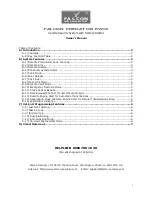
9
Transient CO situations can occur:
1.
Excessive spillage or reverse venting of fuel burning appliances caused by outdoor ambient conditions, such as:
a)
Wind direction and/or velocity, including high gusts of wind. Heavy air in the vent pipes (cold/humid air
with extended periods between cycles).
b)
Negative pressure differential resulting from the use of exhaust fans.
c)
Simultaneous operation of several fuel-burning appliances competing for limited internal air.
d)
Vent pipe connections vibrating loose from clothes dryers, furnaces, or water heaters.
e)
Obstruction or unconventional vent pipe designs, which can amplify the above situations.
2.
Extended operation of un-vented fuel burning devices (range, oven, fireplace, etc.).
3.
Temperature inversions, which can trap, exhaust gasses near the ground.
4.
Car idling in an open or closed attached garage, or near a home.
(UL 2034)
The CM-E1 will automatically stop alarming once the air clears, timing will depend on the CO exposure time and the CO
level.
RESET/SILENCE SWITCH
The switch on the front of the CM-E1 labeled “TEST/RESET,” performs four functions.
1.)
A short press of switch, less than 5 seconds, will place the unit into self test mode with no alarm relay activation. The
buzzer will sound for two complete alarm cycles, the status light will turn red for 5 seconds and then it will alternate
slowly between green and amber while the self-test executes. The controlling software simulates a 3000 ppm CO
environment and causes the unit to alarm after approximately one minute has elapsed. When this happens, the
status light turns red and the buzzer will sound two complete alarm cycles. The unit will then return to normal
operation.
2.)
A long press of switch, 5 or more seconds long, will place the unit into self-test mode with alarm relay activation.
Pressing and holding the switch will cause the buzzer to sound for two complete alarm cycles and status light to turn
red for 5 seconds and then switch to solid amber. The alarm relay will then be activated and the switch can be
released. After about 5 seconds, the alarm relay will turn off and the status light will alternate slowly between green
and amber while the self test executes. The controlling software simulates a 3000 ppm CO environment and causes
the unit to alarm after approximately one minute has elapsed. When this happens, the status light turns red and the
buzzer will sound two complete alarm cycles. The unit will then return to normal operation.
3.)
If the CM-E1 is in an alarm condition due to the detection of carbon monoxide, one push of the switch will cause the
alarm buzzer to mute for five minutes. After the five-minute period, if CO is still present, the status light will again
switch to RED, the alarm relay will close and the buzzer will sound. If after the five-minute period, the detected CO
level has dropped below 70ppm, the CM-E1 unit will reset.
4.)
If the CM-E1 is at the end of its seven year life the TEST/RESET switch can be used to temporarily silence the
buzzer function. See section "End-of-life Indicator"
Do not cover or obstruct audible alarm opening or visual alarm LED. Doing so may adversely affect product performance and result
in sickness or death.
TROUBLE INDICATOR
Internal failure of the CM-E1 will cause an open circuit in the normally closed (NC) Trouble Relay to provide for actuation
of the control panel circuits. The status LED will flash AMBER and the CM-E1 buzzer will emit a short “chirp” every 50
seconds. See ERRORS section. The CM-E1 microprocessor continuously monitors various detector parameters. Failure
of the CM-E1’s internal power supply or a lack of power to the detector will result in the status light remaining OFF (not
illuminated). In this case, the most common cause of detector trouble would be a break in the wiring between the control
panel and the CM-E1.
END-OF-LIFE INDICATOR
! WARNING



























